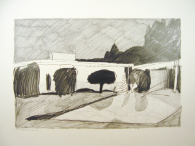February 2010 — Landscape Edition
The start of the new decade brings a slew of new art shows to North Brooklyn in which landscape plays a central role. Here are some of our favorites.
BENNETT MORRIS, “CLIMATE UNTAMED”
Like the Spice Gallery
224 Roebling St.
through 2/14
Bennett Morris conjures phosphorescent beauty from post-apocalyptic landscapes in his photographs of sculptural models. At his studio, Morris constructs elaborate sets out of found objects and submerges them under water. He then adds pigments to the water, creating smoky swirls of color around the topsy-turvy structures. Finally, he photographs the results, the finished products resembling dystopian versions of Romantic landscape paintings from the 19th century.
While the Hudson River School idealized the splendor of America’s natural wonders, Morris fixates on scenes of ruination. Architectural and infrastructural elements are ripped from their rightful places and twisted into masses of steel, rock, and soil. Still, one cannot help but feel stupefied by his foggy, alien-like skies, which seethe with toxic tones of orange, green, pink, and yellow.

Larissa Sansour’s film stills, “printbrightearth” Space Earth C-Print / 2009 Photo courtesy of the artist and Jack The Pelican Presents.
LARISSA SANSOUR, “A SPACE EXODUS”
Jack the Pelican Presents
487 Driggs Ave.
through 2/7
“Jerusalem, we have a problem,” says Palestinian artist Larissa Sansour in the opening lines of her spunky short film “A Space Exodus.” The project riffs on “2001: A Space Odyssey,” with Sansour playing the first “Palestinaut” in a fantasy world where Palestine has achieved superpower status and its people are at liberty to roam freely. Close-up shots linger on the artist’s unconventional spacesuit before she bounds across the moon to plant a Palestinian flag on the lunar surface. In the end, she floats into outer space, a vagabond fetus-woman in the cosmic womb.
Sansour has said she’s grown tired of seeing depressing depictions of Palestinian life in news and documentary footage. So she plucks references from popular culture to lightheartedly confront heavy topics concerning Palestinian politics.
What’s remarkable about this seemingly straightforward film is the myriad ways it elicits interpretation. For one, it could be a spoof on conspiracy theories surrounding the validity of the American moon landings. (Sansour’s special effects look remarkably realistic.) Additionally, the lonely, drifting “Palestinaut” may serve as an autobiographical character—the artist has lived in Jerusalem, Bethlehem, London, Baltimore, New York, and Copenhagen, and now constantly tours the global art circuit. On top of that, the barren moonscape may represent the shabby territory that Palestine currently occupies, a far cry from what the nation once had, or what, Sansour believes, it will have in the future.
SASHA BEZZUBOV, “WILDFIRE”
Front Room Gallery
147 Roebling St.
through 2/14
When contemplating the aftermath of a fire, we tend to think in shades gray and black, as seen in a spent campfire or a crispy matchstick. Sasha Bezzubov’s photographic series of California wildfires shows that blazes often wash the land in dusty tan hues, as well as black and gray. Perhaps the surprising tawniness comes from the newly exposed dirt or from the ash itself. Or it could be that Southern California is always slightly tan.
This soft tonality, combined with the photographer’s knack for sharp focus, brings a gentle airiness to the scenes of devastation. Whether Bezzubov points his camera at a charred lawn ornament or the ruins of an entire neighborhood, he captures the stories of real places that have been wiped bare by catastrophe, but with the understanding that they will someday thrive again.
CHESTER NIELSEN, “CALIFORNIA HOUSES”
Art 101
101 Grand St.
through 2/28
Upon encountering the plethora of drawings that populate the walls of Art 101, I was initially underwhelmed by what looked like quick sketches of suburban homes—until the gallerist pulled out a little book of snapshots. The project has a strong conceptual bent, after all.
New York-based architect Chester Nielsen was driving through his hometown in California during the holidays when he decided to photograph tract houses decked out in Christmas lights. He originally intended to give the photos away in a homemade book for Christmas, but the pictures sparked an inspiration in the artist. He found himself building cardboard models of the homes. Then he photographed the models in the same head-on fashion he had shot the houses. Lastly, he sketched the photos of the houses and the cardboard models.
The project became a yearlong obsession for Nielson and is now a tricky meta-experience for the viewer. Are we looking at drawings of houses or drawings of photos of models of houses? The drawings themselves are punchy and spare, with squiggly lines and minimal shading, as though composed with urgency. In the end, though, Nielson never quite transcends the realm of architectural drafting, but at least he sticks with what he knows.



Leave a Reply